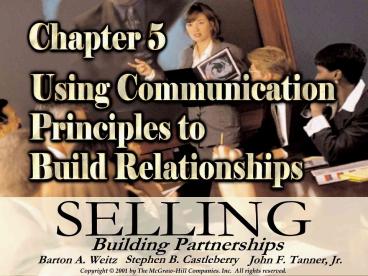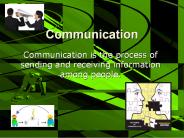The Communication Process - PowerPoint PPT Presentation
1 / 29
Title:
The Communication Process
Description:
Open questions encourage customers to speak freely. ... Navy, black, and gray suits worn with light-colored blouses are part of any wardrobe. ... – PowerPoint PPT presentation
Number of Views:66
Avg rating:3.0/5.0
Title: The Communication Process
1
(No Transcript)
2
The Communication Process
Exhibit 5.1
Message
Noise
Encodes
Receiver
Sender
Decodes
Feedback
5-2
3
Effectiveness of Different Methods of
Communication
Exhibit 5.2
5-3
4
Modes of Communication
5-4
5
Making Verbal Communication Effective Effective
Use of Words
Use concrete rather than abstract words.
- Rephrase this to make it more concrete
- We offer a great warranty.
- Which is more effective?
- We ship orders quickly.
- We ship orders within 24 hours after receiving
them.
5-5
6
Making Verbal Communication Effective Effective
Use of Words
Use similes
- A simile compares two unlike things using words
such as like or as. - This battery backup is like a spare tire.
Describe a recent shopping experience using a
simile.
5-6
7
Making Verbal Communication Effective Effective
Use of Words
Use metaphors
- A metaphor is a word or phrase denoting one kind
of object used in place of another to suggest a
likeness or analogy. - This machine is a real workhorse.
Describe a recent shopping experience using a
metaphor.
5-7
8
Making Verbal Communication Effective Effective
Use of Words
Dont use words that trigger fear
Exhibit 5.3
Source Francy Blackwood, Back to Basics,
Selling, April 1996, p. 39. Reprinted with
permission from Institutional Investors, Inc.
5-8
9
Making Verbal Communication Effective Effective
Use of Words
- Paint word pictures.
- A story designed to help the buyer visualize a
point.
Think of yourself hanging by a thread over a
deep gorge. Your pulse pounds. You cant look
down. Dont make any sudden moves!
Think of the last time you went on vacation.
Describe the experience using word pictures.
5-9
10
Making Verbal Communication Effective Effective
Use of Words
Tailor your words to the customers preferred
communication style.
- Some people see things, others hear or feel them.
- I see what you mean. That rings a bell. That
feels right.
Describe this classroom 3 times, each time using
words appropriate for a person who uses visual,
auditory, or touch words.
5-10
11
Guidelines for Asking Questions
Use open-ended questions
- Open questions encourage customers to speak
freely. - Since there are no simple answers, these
questions encourage longer responses.
5-11
12
Guidelines for Asking Questions
Use closed-ended questions judiciously.
- Closed-ended questions can be answered with a
word or short phrase. - Closed-ended questions pin down specifics and
confirm understanding.
5-12
13
Guidelines for Asking Questions
Space out questions.
- When salespeople ask several questions, one right
after another, customers may feel threatened. - They may feel they are being interrogated rather
than participating in a conversation. - If a number of questions are really necessary,
the salesperson might ask a permission question
first.
5-13
14
Guidelines for Asking Questions
Ask short, simple questions.
- Avoid asking questions that ask for two different
kinds of information. - The customer may not know which part to answer.
5-14
15
Guidelines for Asking Questions
Avoid leading questions
- Questions should not suggest an appropriate
answer. - Try to draw out what the customer actually thinks.
5-15
16
Guidelines for Asking QuestionsAsk questions to
collect information.
Ask questions to collect information
- These questions usually start with who, what,
where, when, why or how. - Questions can be used to
- Uncover specific facts.
- Discover the customers feelings.
- Get customers to articulate a specific problem.
5-16
17
Guidelines for Asking QuestionsAsk questions to
maintain information flow.
Ask questions to maintain information flow
- Use brief verbal responses, such as Really?,
Uh-huh, or Thats interesting. - Use requests for additional information, such as
Can you give me an example of what you mean? - Make neutral statements that reaffirm a
customers comment, such as You said you were
dissatisfied with your present service?
5-17
18
Guidelines for Asking QuestionsAsk questions to
maintain information flow.
- Write down a list of questions you would ask a
prospective buyer for a residential home if you
were a real estate salesperson. Be sure to - Encourage longer responses
- Space out questions
- Ask short, simple questions
- Avoid leading questions
- Ask questions to collect information
- Ask questions to maintain information flow
5-18
19
Suggestions for Active Listening
- Repeat information
- Restate or rephrase information
- Clarify information
- Summarize the conversation
- Tolerate silences
- Concentrate on what is being communicated
5-19
20
Reasons for Listening
- Clears the air lets someone get a problem off
their chest - Learning
- Helps speaker solve a problem
- Stimulates speaker
- Involves speaker in conversation
- Leads to mutual problem solving
- Gives you a chance to think
5-20
21
Good and Bad Listeners
Good Listener
Poor Listener
5-21
22
Reading the Customers Non-Verbal Communication
- Body angle
- Face
- Arms
- Hands
- Legs
- Body language patterns
- Detecting hidden emotions
5-22
23
Patterns of Nonverbal Reactions to Presentation
Exhibit 5.5
5-23
24
Sending Non-Verbal Communication
- Body language
- Face
- Eye contact
- Hand movements
- Posture and body movements
- Matching customers communication style
5-24
25
Distance Zones for Interaction
- Intimate zone
- 0-2 feet
- Personal zone
- 2-4 feet
- Social zone
- 4-12 feet
- Public zone
- More than 12 feet
Exhibit 5.6
5-25
26
Dress for Success Men
- In general, darker suits give a more
authoritative image lighter colors create a
friendlier one. - Pinstripes convey the most authority, followed by
solids. - Solid white shirts or shirts in pastel colors.
- Let the tie provide the accent color.
5-26
27
Dress for Success Women
- Navy, black, and gray suits worn with
light-colored blouses are part of any wardrobe. - Add suits in more cheerful shades, wool or silk
dresses with jackets, and blazers with
coordinated skirts. - Silk scarves can add flair and a touch of color.
- Hairstyle should be subtle and comfortable.
5-27
28
Adjusting for Cultural Differences
- Use of Language
- Use common English words
- Use words with fewest alternative meanings
- Avoid slang
- Use proper rules of grammar
- Use action-specific rather than action-general
verbs - Time and Scheduling
- Perception of time varies
- Time for business activities varies
5-28
29
High and Low Context Cultures
Exhibit 5.7
5-29































